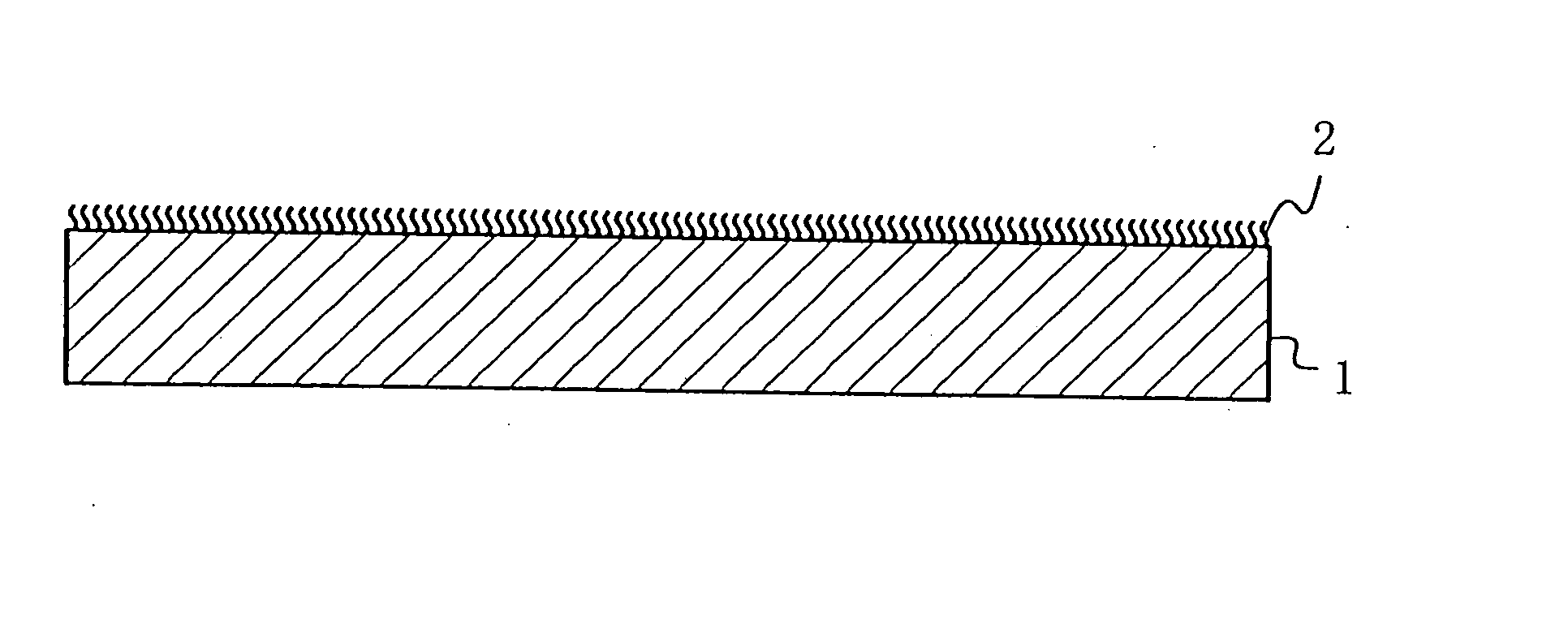Polishing pad for cmp, method for polishing substrate using it and method for producing polishing pad for cmp
a technology of polishing pad and cmp, which is applied in the direction of flexible wheel, manufacturing tools, grinding devices, etc., can solve the problems of insufficient speed of polishing inorganic insulation film, ineffective reduction of polishing flaws, and insufficient hardness of pad surface, so as to suppress the occurrence of polishing flaws
- Summary
- Abstract
- Description
- Claims
- Application Information
AI Technical Summary
Benefits of technology
Problems solved by technology
Method used
Image
Examples
example 1
[0061] A release film (a 50.mu.m-thick polypropylene film) was put on both surfaces of a prepreg layer consisting of 15 sheets of prepreg "1," put in layers. They were sandwiched between mirror-finished plates and thermocompression molded (temperature: 175.degree. C., pressure: 400 kPa, time: 120 min.) between pressing hot plates, with two sheets of 10 mm-thick cushion interposed, to give a 1.5 mm-thick laminate. A polishing pad was produced by sticking the laminate to the fixing disc of a polishing machine, and dressing it with a diamond whetstone of #70 count for 10 minutes under a pressure of 8820 Pa (90 g / cm.sup.2) at revolutions of 38 rpm to form a very thin layer of exposed aramid fibers on a surface. The exposed parts of the aramid fibers had a fiber length of 1 mm and a fiber diameter of 12.5.mu.m.
example 2
[0062] A polishing pad was produced by sticking a laminate, which was produced in the same manner as in Example 1, to the fixing disc of a polishing machine, and dressing it with a diamond whetstone of #150 count for 10 minutes under a pressure of 8820 Pa (90 g / cm.sup.2) at revolutions of 38 rpm to form a very thin layer of exposed aramid fibers on a surface. The exposed parts of the aramid fibers were shorter than those of Example 1, and had a fiber length of 500 .mu.m and a fiber diameter of 12.5 .mu.m.
examples 3 to 7
Production of Pad
[0073] The following organic fibers were prepared as raw materials.
[0074] [Polyester Fiber Base Material "1"]
[0075] A non-woven fabric consisting of polyester fibers having a fiber diameter of 12.5.mu.m and a fiber length of 5 mm and having a unit weight of 70 g / m.sup.2 ([EPM-4070TE] produced by Nippon Byleen Co., Ltd.).
[0076] [Aramid fiber base material "2"]
[0077] Para-aramid fiber chops (fiber diameter: 12.5.mu.m, fiber length: 5 mm, "KEVLAR" produced by DuPont Kabushiki Kaisha), para-aramid fiber pulps (fiber diameter: 0.83.mu.m, fiber length: 1 mm, "KEVLAR" produced by DuPont Kabushiki Kaisha) and meta-aramid fiber chops (fiber diameter: 25.mu.m, fiber length: 6 mm, softening temperature: 280.degree. C., "CORNEX" produced by Teijin Ltd.) were mixed and made into a mat. A 20% by weight aqueous solution of a water-soluble epoxy resin binder (glass transition temperature: 110.degree. C., trade name: "V-COAT", produced by Dainippon Ink & Chemicals, Inc.) was sprayed...
PUM
| Property | Measurement | Unit |
|---|---|---|
| diameter | aaaaa | aaaaa |
| length | aaaaa | aaaaa |
| length | aaaaa | aaaaa |
Abstract
Description
Claims
Application Information
 Login to View More
Login to View More - R&D
- Intellectual Property
- Life Sciences
- Materials
- Tech Scout
- Unparalleled Data Quality
- Higher Quality Content
- 60% Fewer Hallucinations
Browse by: Latest US Patents, China's latest patents, Technical Efficacy Thesaurus, Application Domain, Technology Topic, Popular Technical Reports.
© 2025 PatSnap. All rights reserved.Legal|Privacy policy|Modern Slavery Act Transparency Statement|Sitemap|About US| Contact US: help@patsnap.com


